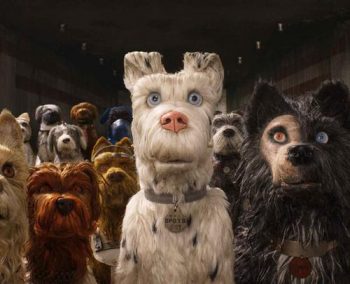
I actually have never seen Anderson’s first stop-motion animated film, Fantastic Mr. Fox (2009), but now that I’ve seen Isle of Dogs, I will definitely seek it out. Stop-motion animation feels like a lost art, in this age of digital everything, but Anderson goes old-school and creates his animated movies the real (and right) way. Stop-motion is a painstakingly detailed and time-consuming process in every way. Over 1,000 puppets were hand-built and over 240 miniature sets were created—every part of the production design and cinematography process is done shot by shot, literally frame by frame. And the result? An absolutely delightful feast for all the senses.
Isle of Dogs is a love letter to Japanese cinema and to man’s best friend. The film could technically be called a Japanese film, as almost all of the human dialogue is in Japanese, and not all of it even gets translated for the English-language audience. The movie is set in Japan and feels, stylistically, in every way as an homage to Japanese cinematic greats, specifically Hayao Miyazaki and Akira Kurosawa. However, no matter the influence and inspiration, enough Anderson creeps in to make Isle of Dogs a most charming, unique and endearing experience.
Isle of Dogs takes place in a fictional place and time in Japan, where dogs have been banished to a remote island called Trash Island. A 12-year old boy, Atari, flies a homemade plane to the island in search of his dog, Spots. When he crash-lands, he is taken in by a pack of alpha dogs, who help him look for Spots, in spite of the evil, cat-loving ruler, who has ordered Atari to be returned and all dogs on Trash Island to be eliminated. As with any good Wes Anderson movie, there are many quirky characters, heart-warming moments, endearing story lines and, of course, adventure. It all is quite charming and delightful.
But Isle of Dogs is also a near cinematic masterpiece. Much like the Toy Story franchise took storytelling and animation to new heights, Isle of Dogs has reached a new level of cinematic beauty. The way Anderson and his team shoot the film, light it, and score it, Isle of Dogs feels and looks like something you would dream: shadows and light, colors and shades, movement and stillness. This film was made by shooting each frame one-by-one and it shows. Every single frame of this film is absolutely gorgeous. Lovingly hand-made, it is truly an experience to savor, like a fine wine.
Credit also should go to the voice actors who bring Anderson’s characters to life. Everyone is excellent, especially Bryan Cranston, Frances McDormand, Greta Gerwig, Liev Schreiber, and Scarlett Johansson. They make the movie warm and inviting, Anderson and his team of magical artists do the rest. Cinematographer Tristan Oliver, Production designers Paul Harrod and Adam Stockhausen, Art Director Curt Enderle, composer Alexandre Desplat and the hundreds of animators, puppet masters, and digital effects artists all deserve to take a bow.
If animation is your cup of tea—and even if it’s not—make an effort to see Isle of Dogs (preferably on the big screen) and bask in the whimsy. The beautiful, heartfelt, charming and soulful whimsy that is Wes Anderson.
